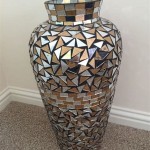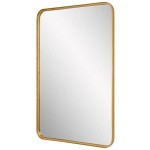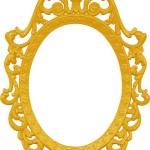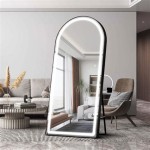How Big Should A Hallway Mirror Be?
A hallway mirror serves both functional and aesthetic purposes. It provides a last-minute check before heading out and can significantly impact the perception of space and light within a hallway. Choosing the right size requires careful consideration of the hallway's dimensions, surrounding decor, and the desired effect.
One fundamental principle to consider is the mirror's proportion relative to the hallway's width. A mirror that is too large can overwhelm a narrow hallway, making it feel cramped. Conversely, a mirror that is too small can appear insignificant and fail to enhance the space. A general guideline suggests that the mirror's width should not exceed the hallway's width, leaving sufficient visual breathing room on either side. Ideally, the mirror should occupy between one-half and two-thirds of the hallway's width.
The hallway's length also plays a role in determining appropriate mirror dimensions. In shorter hallways, a larger mirror can create the illusion of greater length by reflecting the space. However, in longer hallways, a smaller mirror may be sufficient to serve its functional purpose without dominating the visual field. The goal is to achieve a sense of balance and harmony within the overall space.
Ceiling height influences mirror placement and size. In hallways with low ceilings, a vertically oriented rectangular mirror or a series of smaller mirrors can create the impression of height. Conversely, in hallways with high ceilings, a horizontally oriented mirror or a larger, statement piece can balance the vertical space and add a touch of grandeur.
The mirror's function should be considered when choosing its size. If the primary purpose is a quick appearance check before leaving the house, a smaller mirror may suffice. This type of mirror should be positioned at a comfortable height for viewing one's reflection, typically eye level for an average adult. However, if the mirror is intended to serve a more decorative purpose or to create a focal point in the hallway, a larger, more elaborate mirror might be appropriate.
Existing furniture and decor within the hallway should also be considered. The mirror should complement the existing style and scale of the furniture. For instance, a large, ornate mirror might look out of place in a minimalist hallway, while a small, simple mirror might get lost in a hallway with more substantial furnishings. Consider the visual weight and style of existing pieces when selecting a mirror to ensure a cohesive and balanced look.
Lighting conditions in the hallway significantly impact the effectiveness of a mirror. A mirror placed opposite a window or light source can reflect light, brightening the hallway and creating a sense of spaciousness. However, in dimly lit hallways, a large mirror might amplify the darkness. In such cases, consider adding additional lighting fixtures near the mirror to maximize its reflective properties and enhance the overall ambiance.
The shape of the mirror can contribute to the overall aesthetic of the hallway. Rectangular mirrors are a versatile choice, suitable for most hallway styles. Round or oval mirrors can soften the lines of a hallway and create a more inviting feel. More unique shapes, such as arched or geometric mirrors, can serve as statement pieces and add a touch of personality to the space.
Beyond basic shapes, the mirror's frame and style should complement the hallway's overall design. A simple, unadorned frame might be suitable for a minimalist hallway, while a more ornate frame could enhance a traditional or eclectic space. The frame's color and material should also harmonize with the surrounding decor, creating a cohesive and visually appealing environment.
Budget is a practical consideration that cannot be overlooked. Mirror prices can vary significantly depending on size, material, and design. Setting a budget beforehand can help narrow down the options and ensure that the chosen mirror fits within the allocated spending limits. Exploring different retailers and comparing prices can help identify the best value for the desired style and size.
Placement of the mirror is crucial for maximizing its impact. Avoid placing a mirror directly across from a cluttered or unattractive area. Instead, position the mirror to reflect a pleasing view, such as a piece of artwork, a well-lit area, or an interesting architectural feature. This can enhance the visual appeal of the hallway and create a more positive and welcoming atmosphere.
Ultimately, selecting the appropriate size for a hallway mirror involves careful consideration of multiple factors. By assessing the hallway's dimensions, existing decor, lighting conditions, and desired effect, one can choose a mirror that enhances the space both functionally and aesthetically. Taking the time to consider these elements will result in a well-integrated and impactful addition to the hallway.

How To Pick The Right Mirror For Your Entryway Gem Picker

Custom Mirror For Entryway Foyer Table Entry Organizer Entrance Furniture

How To Pick The Right Mirror For Your Entryway Gem Picker
Entryway And Foyer Mirrors Don T Miss Out On This Design Element Abc Glass Mirror

Console Tables And Round Mirrors A Perfect Combination

18 Hallway Mirrors To Create The Illusion Of Space

18 Hallway Mirrors To Create The Illusion Of Space

Hallway Mirror Ideas That Solve Your Decor Issues

40 Entryway Mirror Ideas That Are Absolutely Captivating

45 Entryway Mirror Ideas That Make An Impression








